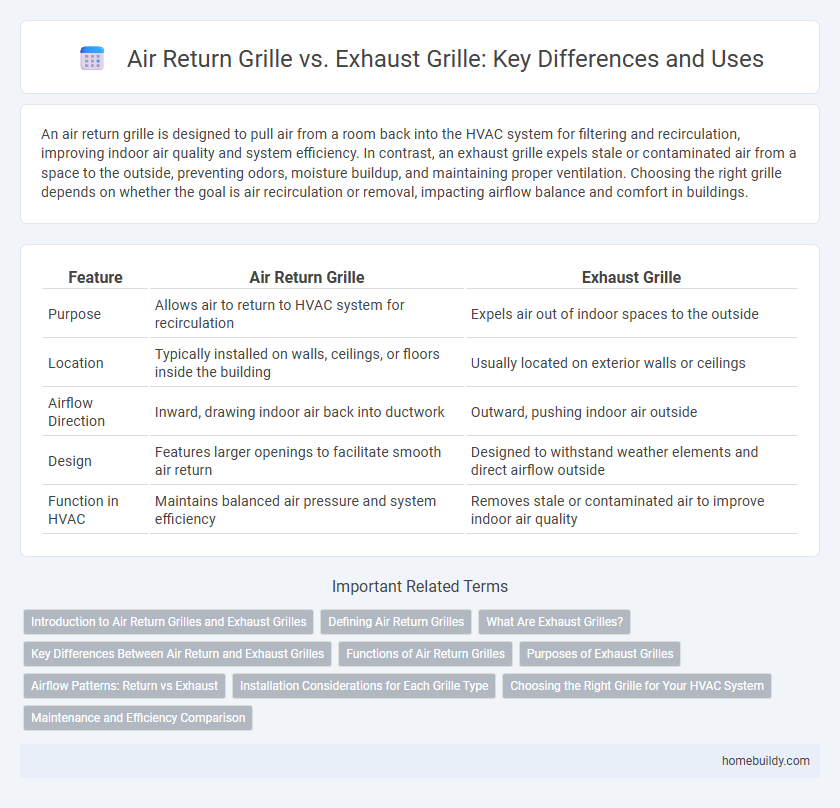An air return grille is designed to pull air from a room back into the HVAC system for filtering and recirculation, improving indoor air quality and system efficiency. In contrast, an exhaust grille expels stale or contaminated air from a space to the outside, preventing odors, moisture buildup, and maintaining proper ventilation. Choosing the right grille depends on whether the goal is air recirculation or removal, impacting airflow balance and comfort in buildings.
Table of Comparison
| Feature | Air Return Grille | Exhaust Grille |
|---|---|---|
| Purpose | Allows air to return to HVAC system for recirculation | Expels air out of indoor spaces to the outside |
| Location | Typically installed on walls, ceilings, or floors inside the building | Usually located on exterior walls or ceilings |
| Airflow Direction | Inward, drawing indoor air back into ductwork | Outward, pushing indoor air outside |
| Design | Features larger openings to facilitate smooth air return | Designed to withstand weather elements and direct airflow outside |
| Function in HVAC | Maintains balanced air pressure and system efficiency | Removes stale or contaminated air to improve indoor air quality |
Introduction to Air Return Grilles and Exhaust Grilles
Air return grilles are designed to facilitate the flow of indoor air back into the HVAC system for reconditioning, maintaining efficient circulation and consistent temperature. Exhaust grilles, on the other hand, serve to expel stale or contaminated air out of a space, improving indoor air quality by removing pollutants and excess moisture. Both components are integral to ventilation systems, with return grilles focusing on air intake and exhaust grilles handling air discharge.
Defining Air Return Grilles
Air return grilles are designed to facilitate the recirculation of indoor air back to the HVAC system for filtering and temperature control, ensuring consistent airflow and maintaining indoor air quality. Unlike exhaust grilles that expel stale air from a space to the outside, air return grilles serve as inlets that draw air into the ventilation system, often located in walls or ceilings. Their structural design prioritizes airflow efficiency and dust filtration, distinguishing them from exhaust grilles that focus on removing contaminants and moisture.
What Are Exhaust Grilles?
Exhaust grilles are ventilation components designed to remove stale air, odors, and pollutants from indoor spaces, directing it out of the building. Unlike air return grilles that recirculate air back into the HVAC system, exhaust grilles focus on expelling unwanted air to maintain indoor air quality. These grilles are commonly installed in bathrooms, kitchens, and other areas requiring effective ventilation and odor control.
Key Differences Between Air Return and Exhaust Grilles
Air return grilles facilitate the circulation of air back to the HVAC system for reconditioning, ensuring efficient airflow and maintaining indoor air quality. Exhaust grilles, in contrast, expel stale or contaminated air from rooms, commonly found in bathrooms and kitchens to control humidity and odors. Unlike exhaust grilles, air return grilles are equipped with filters to trap dust and particulates, playing a crucial role in the HVAC system's air filtration process.
Functions of Air Return Grilles
Air return grilles are designed to facilitate the circulation of air by drawing indoor air back into the HVAC system for reconditioning, ensuring efficient temperature regulation and air quality maintenance. Unlike exhaust grilles, which expel stale air from a space to the outside, air return grilles maintain balanced air pressure and improve energy efficiency by enabling continuous air recirculation. Their strategic placement and proper sizing are critical for optimal airflow, system performance, and overall indoor comfort.
Purposes of Exhaust Grilles
Exhaust grilles serve the essential function of removing stale air, contaminants, and excess moisture from indoor spaces to maintain air quality and prevent buildup of pollutants. Unlike air return grilles that facilitate air recirculation into HVAC systems, exhaust grilles are specifically designed to expel air outside the building, enhancing ventilation efficiency. Proper placement and sizing of exhaust grilles ensure effective extraction of odors, heat, and airborne particles from kitchens, bathrooms, and industrial environments.
Airflow Patterns: Return vs Exhaust
Air return grilles facilitate the smooth intake of indoor air back into the HVAC system, promoting balanced airflow and maintaining consistent indoor pressure. Exhaust grilles, in contrast, expel stale air from indoor spaces to the outside, directing airflow outward to prevent pollutant buildup. Understanding the distinct airflow patterns of return and exhaust grilles ensures optimal ventilation efficiency and indoor air quality.
Installation Considerations for Each Grille Type
Air return grille installation requires placement in areas that facilitate efficient airflow back to the HVAC system, typically in walls or ceilings away from direct exhaust airflow to prevent system inefficiency. Exhaust grille installation should focus on locations that effectively expel stale air from rooms, often near kitchens or bathrooms, ensuring proper sealing to avoid air leakage and moisture issues. Proper sizing and secure mounting are crucial for both grille types to maintain optimal ventilation performance and indoor air quality.
Choosing the Right Grille for Your HVAC System
Air return grilles are designed to pull air back into the HVAC system for filtering and recirculation, whereas exhaust grilles expel stale air out of the space. Selecting the right grille depends on airflow requirements, grille size, and location within the system to maintain optimal ventilation and energy efficiency. Proper placement of air return grilles ensures balanced pressure and improved indoor air quality, while exhaust grilles prevent the buildup of unwanted pollutants.
Maintenance and Efficiency Comparison
Air return grilles require regular cleaning to prevent dust buildup that can reduce airflow efficiency and strain HVAC systems, while exhaust grilles generally experience less contamination due to their role in expelling air. Efficient maintenance of air return grilles ensures optimal indoor air quality and system performance by allowing unobstructed air circulation. In contrast, neglecting maintenance on return grilles can lead to increased energy consumption, whereas exhaust grilles primarily impact air expulsion efficiency if blocked or damaged.
Air return grille vs Exhaust grille Infographic

 homebuildy.com
homebuildy.com